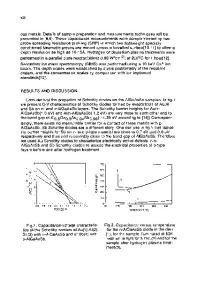The Effect of Hydrogenation on the Electrical Properties of Crystalline Silicon
- PDF / 1,299,679 Bytes
- 12 Pages / 420.48 x 639 pts Page_size
- 19 Downloads / 296 Views
THE EFFECT OF HYDROGENATION ON THE ELECTRICAL PROPERTIES OF CRYSTALLINE SILICON
JACQUES I. PANKOVE Department of Electrical & Computer Engineering, University of Colorado, Boulder, Colorado 80309-0425 and National Renewable Energy Laboratory, Golden, Colorado 80401
ABSTRACT Hydrogen ties Si dangling bonds at defects as well as near impurities. Defect passivation leads to dramatically lower surface recombination and increased minority carrier lifetime. Dopant neutralization increases the resistivity of the crystal and the mobility of carriers. The neutralization of donors and acceptors is optimum at different temperatures. Deep levels can also be neutralized. INTRODUCTION A study of the role of H in hydrogenated amorphous silicon, a-Si:H, in the mid'70s stimulated the interest in what role it might play in crystalline silicon, c-Si. The importance of H in a-Si:H is as a beneficial neutralizer of Si dangling bonds 1,2,3]. W-Vith H, the density of gap states due to dangling bonds in a-Si:H can be reduced from about 1020 cm- 3 to about 1015 cm- 3 . Crystalline Si also has dangling bonds. These are found at the surface, in grain boundaries, in dislocations, in regions of ion implantation, and near dopants. A thorough study of the influence of H on all these defects has been done by many researchers in the '80s [4]. Here we shall review the main effects on the electrical properties of c-Si, although there are significant effects on the optical properties as well. PASSIVATION OF DEFECTS Passivation of Surface States The greatest defect in a single crystal is its termination at the surface. This leaves a great number of dangling bonds that grab atoms from the ambient or reconstruct by deforming the surface layers. The major consequence of surface dangling bonds is the formation of surface states that act as recombination-generation centers. Terminating the surface dangling bonds with H atoms would eliminate the surface states. From the study of a-Si:H, we learned that H binds to Si more strongly than does Si to Si. Since the energy gap of a semiconductor reflects its average binding energy, it is no surprise that the energy gap of a-Si:H is larger than that of c-Si. Thus one might expect an H-induced bandgap widening at the surface of c-Si treated with atomic H. This gap widening would produce an electron-repelling potential barrier at the conduction band and a hole-repelling barrier at the valence band (Figure 1). Such a structure would eliminate surface recombination. The surface passivating property of atomic H was tested on an array of p-n junctions [5]. The test consisted of comparing the I(V) characteristics of these junctions before and after the H treatment. Figure 2 shows the reverse bias I(V) characteristic of such a p-n junction. Exposure to atomic hydrogen for 1/2 hour at 300 *C resulted in a substantial decrease in leakage current. Heating the silicon at 550 *C drives off most of the hydrogen, thus restoring most of the surface states and returning the I(V) characteristics to a leaky condition.
Mat. Res. So
Data Loading...


